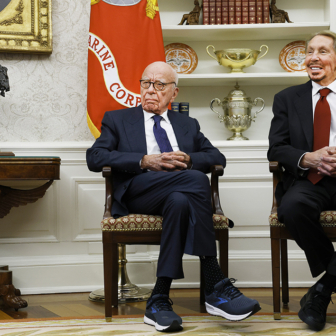In 1999, after Indigenous AFL player Nicky Winmar hadn’t turned up for an interview on Channel Nine’s The Footy Show, Sam Newman thought it would be clever to impersonate him in blackface.
Newman subsequently defended the “skit” along these lines: Winmar is black, I was impersonating a black man, therefore I wore black make-up. It wasn’t racist.
This week Herald Sun cartoonist Mark Knight, whose drawing of tennis player Serena Williams at the US Open final has rapidly gained infamy around the planet, explained himself in similar vein. “I drew her as an African-American woman,” he has been quoted as saying. “She’s powerfully built. She wears these outrageous costumes when she plays tennis. She’s interesting to draw. I drew her as she is, as an African-American woman.”
To him it’s like John Howard’s big lower lip, Bob Hawke’s hair or Tony Abbott’s red speedos. Cartoonists, particularly Australian ones, take no prisoners when roasting public figures, and why should an African American woman get special treatment?
Many have pointed out the context: a history of demeaning representations of African Americans, and indeed of Indigenous Australians. It has been noted in the United States that Knight’s drawing of Williams is “Sambo-like.” But the world is not America. Let’s give Knight the benefit of the doubt when he insists he was unaware his work sat inside that odious genre.
There’s something else about his cartoon. Caricatures are supposed to draw on physical features of a person to elaborate on something in the personality or public persona. Hawke’s hair and his vanity, Paul Keating the undertaker with that ghostly pallor, Malcolm Turnbull, hooded eyes in top hat, the out-of-touch toff, Abbott in red speedos, all clumsy testosterone, boyish and out of control.
But if your “caricature” of a black person is simply an exaggerated account of their blackness — the stereotypical big lips, flat nose and frizzy hair — then you’re not trying very hard. Knight says he finds her “interesting to draw,” but that’s hard to believe because the cartoon doesn’t really look like her. Instead, as he indicated (twice), it was “an African-American woman.” And his previous renderings of African gang members in Melbourne, which have also caused controversy, have had no facial features at all.
They say people have trouble distinguishing between people of another race. It seems Knight does. I’ll draw her big and black, that’ll do, they’ll know who I mean.
You don’t expect elegant wit or finesse from tabloid newspaper cartoons; what you see is generally what you get. But even by those standards Knight’s is a drawing devoid of anything resembling humour or insight, or any reflection on what happened on the court last weekend. Just a caricature of a big black woman throwing a tantrum.
News Corp never backs down, let alone apologises (unless legally obliged). Instead, they’ve characteristically doubled down, with today’s Hun front page showing yesterday’s effort — along with other unkind Knight depictions of a variety of white male figures, as well as Pauline Hanson and Kim Jong Un — and screeching about political correctness. But all of the others are instantly recognisable. None, not even Kim, is a lazy trope.
Newman, who repeatedly finds himself having to insist he’s not racist, went on a decade later to compare Serena Williams to a monkey.
Knight is no Newman, and he’s probably not alone among white cartoonists in having trouble with people of other races. But his black people are just black, nothing else. Is that how his bosses like it? ●





